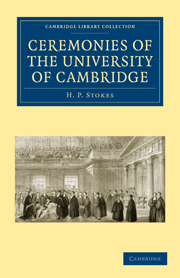Book contents
- Frontmatter
- Prefatory Note
- Contents
- ILLUSTRATIONS
- The Chancellor
- The Vice-Chancellor
- The Registrary
- The Proctors
- The Esquire Bedells
- Matriculation
- Congregations and Graces
- Degrees
- Commencement Day
- Insignia Doctoralia
- Honorary Degrees
- University Costume
- Processions
- The Presentation of an Address to H.M. The King
- The Bidding Prayer
- University Sermons
- The Orator
- The High Steward
- Representation in Parliament
- The Commissary
- University Discipline; the Sex Viri, etc.
- H.M. Judges and Trinity College
- The Admission of the newly elected Master of Trinity
- Commemoration of Benefactors
- The University and College Chests
- Obsolete Officers
- The University and Stourbridge Fair
- The University Arms
- The University Motto
- Index
- Plate section
- Frontmatter
- Prefatory Note
- Contents
- ILLUSTRATIONS
- The Chancellor
- The Vice-Chancellor
- The Registrary
- The Proctors
- The Esquire Bedells
- Matriculation
- Congregations and Graces
- Degrees
- Commencement Day
- Insignia Doctoralia
- Honorary Degrees
- University Costume
- Processions
- The Presentation of an Address to H.M. The King
- The Bidding Prayer
- University Sermons
- The Orator
- The High Steward
- Representation in Parliament
- The Commissary
- University Discipline; the Sex Viri, etc.
- H.M. Judges and Trinity College
- The Admission of the newly elected Master of Trinity
- Commemoration of Benefactors
- The University and College Chests
- Obsolete Officers
- The University and Stourbridge Fair
- The University Arms
- The University Motto
- Index
- Plate section
Summary
The University has power to prescribe from time to time by Grace the form and manner of holding a Congregation, the conditions under which Graces, having received the sanction of the Council, may be offered to the Senate, the mode of taking votes and recording results, and generally to regulate its own proceedings.
Graces which are offered to the Senate for its sanction are read at a Congregation by the Senior Proctor. Any member of the Senate who objects to any Grace may signify his opposition by pronouncing the words “Non placet” immediately after such Grace has been read. The Senior Esquire Bedell calls “Ad Scrutinium,” and other members of the Senate desiring to vote then take their places, sitting down, on the Placet (south) and Non placet (north) sides respectively of the Senate House. If in the opinion of both the Proctors the result of the division is obvious, the Senior Proctor declares the result forthwith, without taking the votes singly; but any two members of the Senate may request the Vice-Chancellor to direct that the votes be taken singly. In this event the vote is taken on cards provided for the purpose, the count being made, and the result announced, by the Proctors.
SUPPLICATS
The theory in conferring degrees is that the candidate applies to the University for the degree to be conferred in a formal petition, called a Supplicat, which is presented on his behalf by the Praelector of his College.
- Type
- Chapter
- Information
- Ceremonies of the University of Cambridge , pp. 27 - 28Publisher: Cambridge University PressPrint publication year: 2009First published in: 1927



